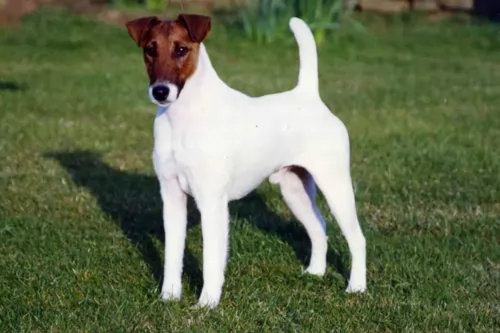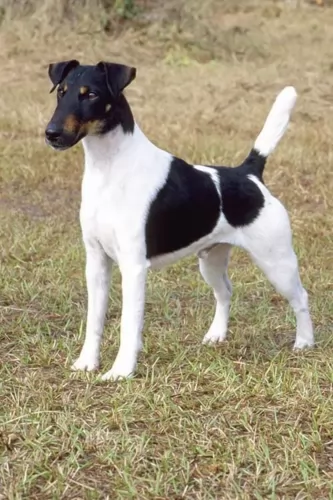 Petzlover
Petzlover Fox Terrier (Smooth) is originated from United Kingdom but Francais Blanc et Orange is originated from France. Fox Terrier (Smooth) may grow 29 cm / 11 inches shorter than Francais Blanc et Orange. Fox Terrier (Smooth) may weigh 27 kg / 59 pounds lesser than Francais Blanc et Orange. Fox Terrier (Smooth) may live 7 years more than Francais Blanc et Orange. Both Fox Terrier (Smooth) and Francais Blanc et Orange has same litter size. Fox Terrier (Smooth) requires Moderate Maintenance. But Francais Blanc et Orange requires Low Maintenance
Fox Terrier (Smooth) is originated from United Kingdom but Francais Blanc et Orange is originated from France. Fox Terrier (Smooth) may grow 29 cm / 11 inches shorter than Francais Blanc et Orange. Fox Terrier (Smooth) may weigh 27 kg / 59 pounds lesser than Francais Blanc et Orange. Fox Terrier (Smooth) may live 7 years more than Francais Blanc et Orange. Both Fox Terrier (Smooth) and Francais Blanc et Orange has same litter size. Fox Terrier (Smooth) requires Moderate Maintenance. But Francais Blanc et Orange requires Low Maintenance
 The Smooth Fox Terrier is one of two Fox Terrier breeds, the other being the Wirehaired Fox Terrier. Fox Terriers are believed to be one of the oldest terrier breeds and the ancestor of many terriers who came after. The Fox Terrier was recognized by the American Kennel Club in 1885 and the smooth Fox Terrier as a separate breed 100 years later in 1985. Some clubs still consider the two types of Fox Terriers as the same breed. The standard for smooth Fox Terrier was written in 1876 but not accepted until 1985.
The Smooth Fox Terrier is one of two Fox Terrier breeds, the other being the Wirehaired Fox Terrier. Fox Terriers are believed to be one of the oldest terrier breeds and the ancestor of many terriers who came after. The Fox Terrier was recognized by the American Kennel Club in 1885 and the smooth Fox Terrier as a separate breed 100 years later in 1985. Some clubs still consider the two types of Fox Terriers as the same breed. The standard for smooth Fox Terrier was written in 1876 but not accepted until 1985.
Both breeds of Fox Terriers are thought to originate in the late 1800’s descended from various British Terriers, the beagle, the dachshund and the Fox Hound. The Smooth Fox Terrier has a base coat that is white. The hunters bred them this way, so they would not mistake them for the fox during the hunt. They have also been very successful in prestigious dog shows including Crufts in England and New York Westminster in the United States.
They are not that popular today unless you are hunting and showing them in Confirmation Competitions. However, the Smooth Fox Terrier is significant because of all the terriers that consider it their direct ancestor. This would include the Jack Russel, the Rat Terrier and the Miniature Fox Terrier.
 The Chien Francais Blanc et Orange is one of the three versions of the Chien Francais. There is the Francais Blanc et Noir and the Francais Tricolor. These scent hounds were distinguished by their colors. The Francais Blanc et Orange like the other two, was a descendent of a variety of English and French hunting hounds, including the Hound of Saintonge.
The Chien Francais Blanc et Orange is one of the three versions of the Chien Francais. There is the Francais Blanc et Noir and the Francais Tricolor. These scent hounds were distinguished by their colors. The Francais Blanc et Orange like the other two, was a descendent of a variety of English and French hunting hounds, including the Hound of Saintonge.
The Hound od Saintonge is extinct but has several breeds coming from his line including the Billy – a pointer. Similar to the Francais Blanc et Orange, the Billy hunted in packs. Coming from these roots the Francais Blanc et Orange was developed around the 1900’s. Many considers the Chien Francais trio to be the Newest and Rarest French Hounds. The Francais Blanc et Orange is a white and orange hound, considered to be the rarest of the three. They were developed by crossing English Foxhounds with French Scent Hounds.
The Francais Blanc et Orange is a born hunter and a good one at that. In his pack he is happy and superbly equipped for the hunt. His vision and scenting skills are unsurpassed. They can cover a large expanse of territory in a very short period of time. They were known for hunting large boar and deer as well as small prey like foxes or rabbits. They were recognized as a separate breed by the UKC in 2006 but are not recognized by the AKC.
 The Smooth Fox Terrier is distinguished from the Wirehaired and other terriers by his V-shaped head and white based coat. The coat can have tan, black and black and tan marks on the white coat. The Smooth Fox Terrier is sturdy, strong, sleek and symmetrical. The breed has a short back, and proportioned legs. The Smooth Fox Terrier has a flat skull and tapered muzzle. The nose is black, and the eyes are dark. He has v-shaped ears and a docked tail. Docking is no longer legal throughout the United Kingdom.
The Smooth Fox Terrier is distinguished from the Wirehaired and other terriers by his V-shaped head and white based coat. The coat can have tan, black and black and tan marks on the white coat. The Smooth Fox Terrier is sturdy, strong, sleek and symmetrical. The breed has a short back, and proportioned legs. The Smooth Fox Terrier has a flat skull and tapered muzzle. The nose is black, and the eyes are dark. He has v-shaped ears and a docked tail. Docking is no longer legal throughout the United Kingdom.
 The Francais Blanc et Orange is a large , muscular and lean hunting dog, a typical pack hound out of France. They have a flat to somewhat domed head, long legs, and dropped, long ears and a square muzzle. The nose is either orange-brown or black and has large nostrils. Their eyes are deep set, dark and widely spaced. They have a deep chest which leads to their propensity toward the situation of bloat. This breed is smaller than the Chien Francais Blanc et Noir that hunts in packs. The skin is the fur’s color. They are athletic and display tremendous perseverance.
The Francais Blanc et Orange is a large , muscular and lean hunting dog, a typical pack hound out of France. They have a flat to somewhat domed head, long legs, and dropped, long ears and a square muzzle. The nose is either orange-brown or black and has large nostrils. Their eyes are deep set, dark and widely spaced. They have a deep chest which leads to their propensity toward the situation of bloat. This breed is smaller than the Chien Francais Blanc et Noir that hunts in packs. The skin is the fur’s color. They are athletic and display tremendous perseverance.
 Children friendliness They shouldn’t be trusted with young children but if raised with older children ok
Children friendliness They shouldn’t be trusted with young children but if raised with older children ok
They are good at performing tricks, Search and rescue, narcotics detection, tracking, and disability assistance.
Fox Terrier is adaptable and can live anywhere. He is not a big dog but remember he is very high energy.
They have very good learning ability and are very intelligent but can be stubborn
 They are not exactly child oriented dogs as they are so oriented toward the hunt and the pack. With serious exercise and mental stimulation, they can become a good family dog, but it is not in their instincts.
They are not exactly child oriented dogs as they are so oriented toward the hunt and the pack. With serious exercise and mental stimulation, they can become a good family dog, but it is not in their instincts.
hunting in packs/scent and vision
He is not suited for apartment life and does need a large, fenced yard to run and play. Being a scent hound, he will constantly be sniffing for a trail to follow so put him to work.
The breed is highly intelligent and easily trainable.
 One of the major problems for the Smooth Fox Terrier that the Wirehaired does not face is the potential for deafness. This is an issue in dogs that are mostly white in color. Other concerns that he does share with the Wirehaired Terrier are:
One of the major problems for the Smooth Fox Terrier that the Wirehaired does not face is the potential for deafness. This is an issue in dogs that are mostly white in color. Other concerns that he does share with the Wirehaired Terrier are:
Causes muscle weakness and problems swallowing.
 As with any dog with log floppy ears, infection is always a concern. Make sure you clean them after every hunting trip, romp or play session.
As with any dog with log floppy ears, infection is always a concern. Make sure you clean them after every hunting trip, romp or play session.
Like many large dogs the Blanc et Orange has a propensity to acquire hip dysplasia. It is known that joint dysplasia has a genetic component and should be screened for. Can cause lameness and arthritis.
This is a real danger for the Blanc et Orange. They are deed chested and these are the dogs that are most likely to get bloat. The stomach is twisted and distended. It can be fatal if not treated quickly.
 Feed 2-3 meals per day and divide 1/8-1/4 cup
Feed 2-3 meals per day and divide 1/8-1/4 cup
Feed two meals per day and divide ½ cup
hearing and vision
The Smooth Fox Terrier is an athlete requiring a lot of exercise. Take him on long walks and play with him in a large fenced yard. Don’t coup him up in the house. Be careful not to exercise him off leash as he will chase anything that moves and will not come when called. They need mental stimulation as well as physical. They are good at hunting, agility, tracking, performing tricks and being a watchdog.
 Until about 18 months of age feed between 1 and 1.5 cups of high quality puppy, dry food, made for sporting dogs. Divide this into 3 meals per day.
Until about 18 months of age feed between 1 and 1.5 cups of high quality puppy, dry food, made for sporting dogs. Divide this into 3 meals per day.
3 cups day – After 18 month feed 3 cups per day of a high quality, adult dry food made for sporting dogs. Divide this into 2 meals per day.
Outstanding scent and vision
Even though they are warm and welcoming to people, these are very serous dogs. They usually live outside in packs as they are an incredible pack animal. All they want in life is to hunt. However, if they cant hunt they need at least a couple hours per day od vigorous exercise. They are obviously better off in a rural environment than a city one. Put him in field trails, scent trials, barn hunt and playing fetch.